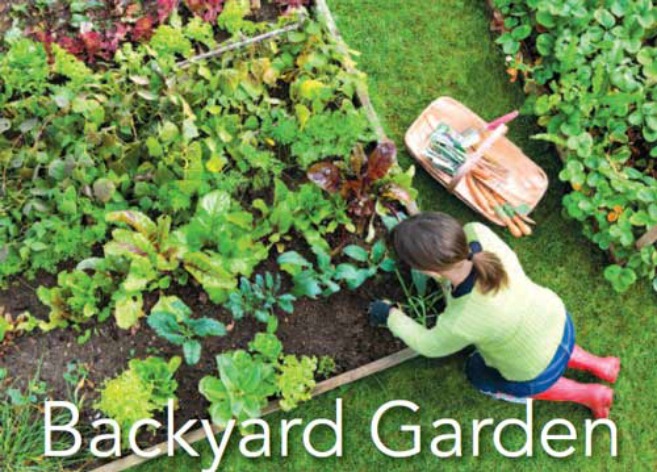Building a Low-Maintenance Organic Garden Even in a Small Yard
If the Obama’s can have an organic vegetable garden, you can too, and you won’t need a big White House lawn and a staff of gardeners to do it! A little bit of planning and some basic knowledge will allow you to have a productive garden that’s easy to manage. April 15th is a good day to start in the Carolinas, but you can plant until the end of May.
Lots of families would like to start a vegetable garden in their back yards, but they never try because they think it will be a lot of hard work. Frankly, they’re right. Digging, tilling and weeding take a lot of time that today’s busy families don’t have.
But there’s a new approach that makes back yard gardening easy. The idea is to build a raised bed garden on top of your existing soil and fill it with weedless potting mix or a blend of compost and sand (75%/25%). This means you won’t be digging in the clay and exposing dormant weed seeds to sunlight to germinate and take over your garden. Since weeding is about 2/3 the work in a garden, all you’ll have to do is plant your seeds and water as needed. That’s something even busy families can do.
Won’t you have to spray for insects and diseases? Organic gardeners know that healthy plants resist bugs and diseases naturally, and the key to healthy plants is healthy soil. Synthetic fertilizers are like an electric shock to a plant, causing it to grow quickly whether it wants to or not. The growth that results is spindly and weak and is the first thing that pests and diseases attack. By using weedless potting mix as your soil and incorporating organic fertilizers, you’ll have perfect garden soil from the start and your plants will be healthy and grow at their own pace, something that takes years for other gardeners to accomplish.
Nowadays many people have a big house and a small yard, and don’t have the room for even a 20 x 20 garden, so 50 square feet of raised beds are a good answer. The key to a small garden is to focus on crops that are most productive and are expensive to buy in grocery stores. Choose plants that don’t take up a lot of room, but offer an ongoing harvest such as leaf lettuce. Use vertical space, too. Try climbing plants like peas, green beans and cucumbers instead of bush varieties. You’ll get more harvest in less room.
Before you buy transplants of every summer crop, know that squash, cucumbers, and beans will sprout from seed in just a few days, and paying $3.18 for a transplant makes very little sense when a whole package of seeds is $1.69. The only transplants you really need are “the big three,” tomatoes, peppers and eggplant.
For transplants, try different varieties. With all the heirloom tomatoes and different peppers and eggplants, it’s a shame to buy Whopper tomatoes and leave it at that. Instead, treat your garden like American Idol for vegetables. Try different varieties and if one doesn’t perform well, vote it off the show. Next season you can keep the winners and bring on new challengers. So expand your tomato horizons along with some of the fun varieties of peppers and eggplants. Garden centers, hardware stores and even big box stores are carrying many more varieties than ever before, often from local growers.
Whether you spend the money on organic seeds and transplants is up to you. Unless it was grown on Three Mile Island or Love Canal, there’s nothing in a seed that will hurt you. It’s the way your plant grows in your garden that determines if it’s organic. Just avoid synthetic fertilizers and pesticides and you’re good to go. With transplants – it’s more important how they’re grown than what they were started in.
Do a bit of thinking, save a bunch of money, and end up with a fantastic summer garden with no weeds! Enjoy your garden!
What to PlantYour garden should face south so the tallest crops won’t shade out the shorter ones during the day, so Rosenburg listed the crops in order of tallest to shortest. Pole beans Experiment with Scarlet Runner, Purple-Podded or other “pole beans” for longer harvest time. Grow them up a trellis that’s on the north side of your garden. Plant a row two feet wide per person. Cucumbers Select seeds for climbing plants, not bush varieties. Two feet of cucumbers will serve one person. Tomatoes Plant transplants at least three feet apart up 8’ stakes and remove the suckers as you go. Tie them up loosely with soft jute twine. A slicing tomato plant will feed two people, a roma or paste tomato plant will feed a single person, and a cherry tomato plant will feed a whole family. Green peppers and eggplants Buy plants instead of starting from seed and experiment with colors, shapes and varieties. Squash plants One plant will serve three people. Resist the urge to start 5 squash plants – you’ll have so many you’ll be sick of them in no time! The rest of your summer garden can be garlic, shallots and onions. They take a bit longer to mature, so plan for them to be there about 5 months before harvest. You’ll find onion sets at the hardware stores and garden centers. |
The Dirt on DirtPotting soil is usually a combination of compost, peat moss and ground tree bark and is an excellent growing medium. The problem is that most potting mix now comes from Scotts or Miracle Gro and contains synthetic fertilizers, which cause unnatural growth in your plants and kill the life in your soil. It’s also your most expensive option. Look for an inexpensive local brand of potting mix with no fertilizers added. Just check the label and make sure you recognize what’s inside is organic to begin with. Compost is any of a number of materials used as soil amendments — cow manure, mushroom compost, leaf mold or compost produced by your city. By itself, compost is not an adequate soil, so add some pine fines (found as “soil conditioner” at the garden center) or common sand. Top soil has absolutely no rules on what it can contain — from soil scraped off of lots before homes are built (full of weed seeds) to “bio solids” which is a polite term for sewage sludge. It’s often your least expensive choice, but I wouldn’t use it on a bet. Add Organic fertilizer and you’re ready to plant. Plant-Tone is great, but my absolute favorite is worm castings. That’s worm poop, but it doesn’t smell bad or look nasty. It’s the perfect blend of nutrition for your new plants and also contains beneficial bacteria and fungi that will wake up the life in your soil and allow your plants to take up the nutrition they need all season long. It’s getting easier to find, so ask around. |





